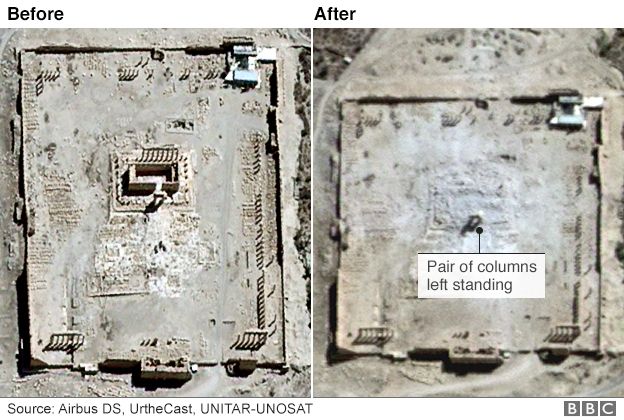Palmyra's Temple of Bel destroyed, says UN
- Published

A satellite image confirms the main temple in the ancient city of Palmyra in Syria has been destroyed by Islamic State (IS) militants, the UN says.
Syria's head of antiquities had suggested on Monday that the Temple of Bel was still standing, despite reports of a massive explosion at the weekend.
But Unosat analysts said the main structure had been reduced to rubble, as well as a line of columns beside it.
IS captured the Unesco World Heritage site from government forces in May.
"Unfortunately, the images we acquired do show that the main building of the temple has been destroyed," Einar Bjorgo, Unosat's manager, told the BBC early on Tuesday.
The United Nations Educational, Scientific and Cultural Organisation (Unesco) considered the Temple of Bel - the great sanctuary of the Palmyrene gods - one of the most important religious buildings of the 1st Century AD in the East.
Maamoun Abdul Karim, the head of the Syrian Department of Antiquities and Museums, said its destruction was a "catastrophe".
"I feel very sad and I am very pessimistic... for the future of Palmyra," he told BBC Radio 5 live.
"I am sure we will have more bad images [in the future] because these people... are ignorant, they are very criminal," he added. "They don't respect any image, any identity of the people."
Ancient city of Palmyra
- Unesco World Heritage site
- Site contains monumental ruins of great city, once one of the most important cultural centres of the ancient world
- Art and architecture, from the 1st and 2nd Centuries, combine Greco-Roman techniques with local traditions and Persian influences
- More than 1,000 columns, a Roman aqueduct and a formidable necropolis of more than 500 tombs made up the archaeological site
- More than 150,000 tourists visited Palmyra every year before the Syrian conflict
Mr Abdul Karim had said on Monday that there was a large explosion at the Temple of Bel, but that he believed most of the site remained intact.
The BBC's Jim Muir in Beirut says the temple is bounded by a high perimeter wall, and the whole sprawling site of Palmyra is controlled by IS, so it would have been hard for outside witnesses on the ground to verify what had happened without putting themselves at risk.
IS has ransacked and demolished several similar ancient sites that pre-date Islam in Iraq, denouncing them as symbols of "idolatry".
The sale of looted antiquities is nevertheless one of the group's main sources of funding. It has also been accused of destroying ancient sites to gain publicity.
Authorities removed hundreds of statues and priceless objects before IS overran Palmyra earlier this year.
Last week, it was confirmed that another important site at Palmyra, the Temple of Baalshamin, had been blown up.
Unosat released satellite images showing the extent of the damage, proving that parts were heavily damaged or completely destroyed.
Earlier last month, the group beheaded 81-year-old Khaled al-Asaad, the archaeologist who had looked after the Palmyra ruins for 40 years.
Historian Dan Cruickshank said any damage done by militants in Palmyra was ''an appalling loss''
The world-famous Greco-Roman ruins of Palmyra are in the desert north-east of the Syrian capital, Damascus.
Syrian government forces have sought to drive IS out of the Palmyra area in recent months and there has been fierce fighting in nearby towns.